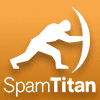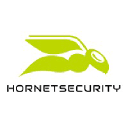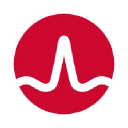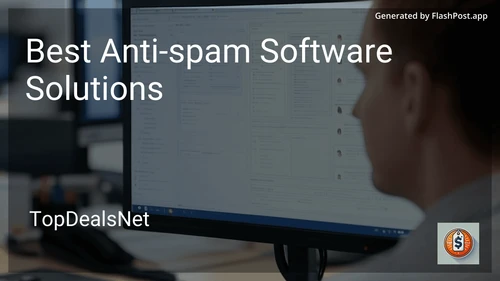Best Anti-Spam Software Solutions in January 2026

SpamTitan
- Advanced email filtering
- Protection against phishing and malware
- Data loss prevention
- Real-time threat intelligence
- Easy integration with existing infrastructure

MailWasher
- Preview and delete emails before downloading
- Whitelist and blacklist capabilities
- Advanced spam filter
- Customizable filters
- Email recycling bin for recovery

SolarWinds MSP Mail Assure
- Threat intelligence feed
- Archiving for compliance
- 24/7 email continuity
- Customizable user interface
- Multi-tenant management

Barracuda Essentials
- Cloud-based email protection
- Data protection and recovery
- Archiving and compliance support
- AI-based threat detection
- Email continuity services

ZEROSPAM
- AI-driven spam detection
- Phishing protection
- Secure email gateway
- Intuitive user interface
- Comprehensive reporting and alerts

Symantec Email Security
- Integrated threat intelligence
- Protection against ransomware and phishing
- Advanced machine learning and analytics
- Cloud-based and on-premises solutions
- Secure email management
In today's digital age, where communication is increasingly reliant on email and instant messaging, the necessity for robust anti-spam software solutions is paramount. Spam, or unsolicited messages, not only clutter your inbox but can also pose significant security risks. To navigate this landscape effectively, selecting the appropriate anti-spam software solution is crucial. This guide explores the importance of anti-spam software solutions, their features, and how to make the best choice for your needs.
Understanding Anti-Spam Software
Anti-spam software is designed to detect, filter, and prevent the influx of unwanted emails or messages into your communication systems. These solutions deploy various techniques to identify and segregate spam from legitimate communications. By employing algorithms, databases, and sometimes user-defined filters, anti-spam software enhances email filtering capabilities, making communication efficient and secure.
Key Features of Effective Anti-Spam Software
Choosing an anti-spam solution involves understanding key features that determine its effectiveness:
1. Email Filtering Capabilities
An essential aspect of any anti-spam software is its ability to filter emails efficiently. Advanced filtering technologies can distinguish between legitimate and unsolicited messages with high accuracy. This includes heuristic filtering, which analyzes the structure and content of emails, and Bayesian filtering, which uses statistical methods to predict spam.
2. Real-Time Blacklist Checks
Effective anti-spam solutions use real-time blacklist (RBL) checks. This involves checking incoming emails against a database of known spam sources. If an email originates from a blacklisted source, it is flagged and filtered out before reaching the user's inbox.
3. Customizable Filters
Businesses often have unique communication needs. Customizable filters allow organizations to set specific rules for categorizing emails, based on criteria such as keywords, sender addresses, and attachment types. This flexibility ensures that the software aligns with the organization’s communication policies.
4. Integration and Compatibility
Anti-spam software should seamlessly integrate with existing email systems and platforms, whether on-premise or cloud-based. Compatibility with various operating systems and email clients ensures a streamlined implementation process and avoids disruptions to daily operations.
5. Scalability
For growing businesses, scalability is critical. Opt for software solutions that can accommodate an increasing volume of emails and adapt to expanding business needs. Scalable solutions prevent the need for frequent replacements or upgrades.
6. Detailed Reporting and Analytics
Monitoring the performance of anti-spam solutions is crucial. Detailed reports and analytics help administrators understand spam trends, filter effectiveness, and make informed decisions about policy adjustments.
How to Choose the Right Anti-Spam Solution
Selecting the right anti-spam software involves assessing specific organizational needs and conducting a thorough market analysis. Here's a generic roadmap to guide the selection process:
1. Assess Organizational Needs
Start by evaluating the volume of emails your organization handles daily and the prevalence of spam issues. Identify any specific challenges or requirements, such as handling emails with large attachments or international sources.
2. Research and Compare Options
Research available anti-spam software solutions, comparing their features, pricing models, and user reviews. Understanding the experiences of similar organizations can provide valuable insights into the effectiveness and usability of various options.
3. Consider Security and Privacy Policies
Ensure that the software complies with industry standards for security and data privacy. This is especially important for organizations dealing with sensitive information, as anti-spam solutions often have access to the content of emails.
4. Trial and Evaluation
If possible, take advantage of trial periods offered by vendors. Conducting a hands-on evaluation allows you to test the software's features, integration capabilities, and overall performance in your operational environment.
5. Make an Informed Decision
After thorough research and testing, choose a solution that aligns best with your organization's needs, budget, and existing technological infrastructure. Ensure the vendor offers reliable technical support and updates to adapt to evolving spam tactics.
Conclusion
The prevalence of spam in today's digital communication landscape requires a proactive approach in selecting effective anti-spam software solutions. By understanding key features and following a structured selection process, organizations can safeguard their communication channels, enhance productivity, and protect their data from malicious threats. As spam techniques evolve, staying informed and vigilant remains the best defense against unwanted digital clutter.
